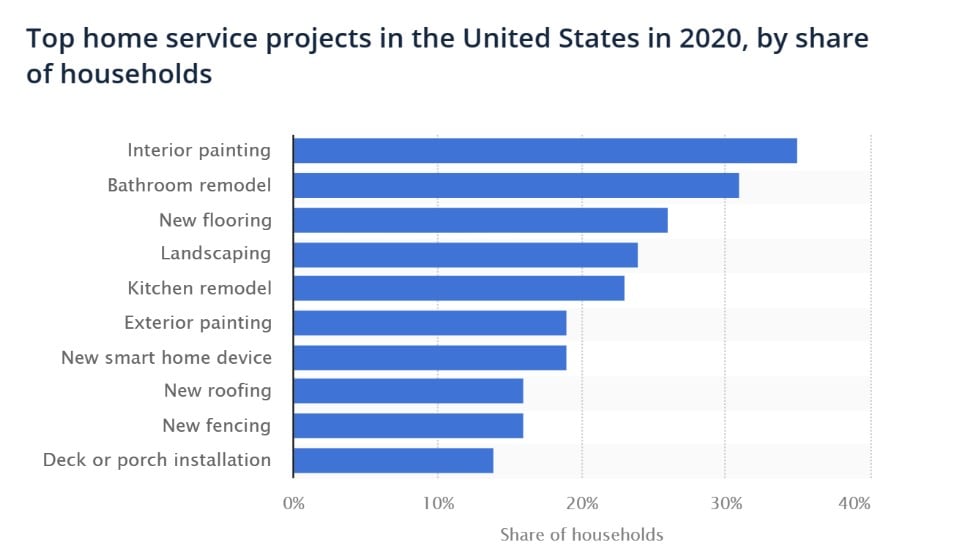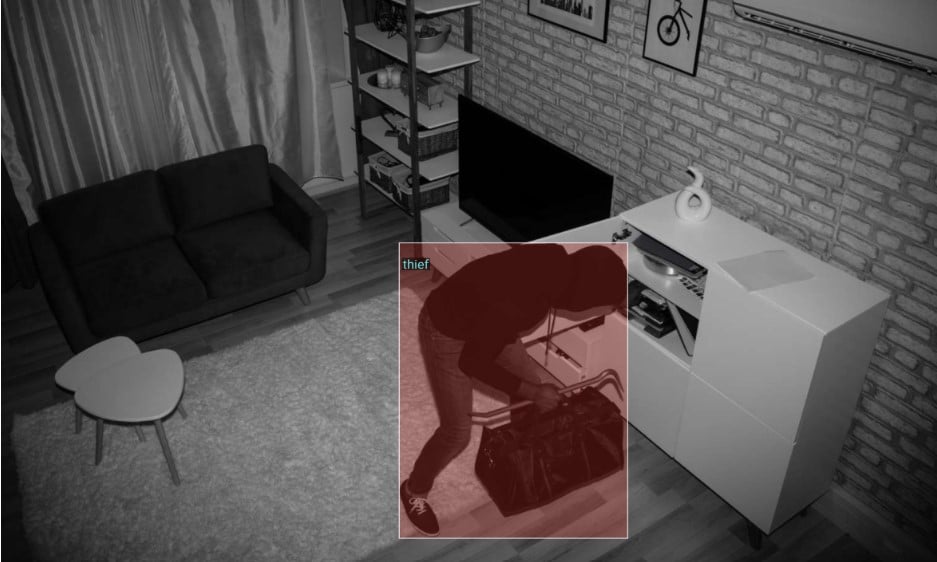Introduction
We do many things daily. We prepare breakfast, make our bed, go to work, spend time with friends, do our hobbies. There is one thought, however, that rarely crosses our minds. ‘Am I safe?’ Mostly, yes, but can this be improved? Has security maybe been neglected lately? Are the systems that we have enough, or do they need modernisation? Can AI help in their improvement, and how? The answers to all these questions are given in this article!
That’s My Safe Place
There is no place like home. Even if you are on vacation in the most beautiful place on Earth or you are simply returning from work, home is where you actually relax and rest. We really value our homes. In fact, the market size of the home improvement industry in the United States has jumped from 294.5 billion dollars to 549.2 billion dollars in 2024, with an expected increase to 602.5 billion dollars in 2027. At the same time, in 2020, 35% of DIY projects focused on interior repainting, followed by bathroom remodelling at 31%. The top 3 are complete with new flooring installation at 26% (Statista - The Statistics Portal). Since the beginning of our history, people have always tried to improve their living spaces, either with decorative alterations or with functional ones. Focussing on the latter, there is one category that is often neglected, maybe because we do not keep it in mind, or maybe we have in mind that ‘it’s not going to happen to us’. This is no other than home security. Let’s see!

In the old days, people were much more consistent with home security, using drawbridges, guard dogs, or even traps on some occasions. As our civilisation progressed and we started having rules, it was decided that it would be better if we were guarded by dedicated groups of people (aka the police), and these methods of the past became kind of obsolete. Due to different factors, these dedicated groups of people have been shown to be ineffective in some circumstances, mainly due to understaffing or funds being redirected to other needs. Burglars are the ideal candidates to take advantage of this situation, and history has shown that they can become very creative! This is where an advanced home security system can shine. And yes, there are already some ‘advanced’ systems out there, but they are not as capable as they could be. Let us explain.
A home security system usually consists of some sensors placed on door frames and windows that are connected to a central unit placed somewhere inside the house. This unit is connected to a siren on the exterior, which rings when a security breach has been made, and it also notifies the police through a subscription plan if desired. However, due to ineffectiveness, though, there is no guarantee that the police will be able to reach you in time, which, in turn, does not guarantee your safety or the identification of the burglars. Surely enough, there are also systems that are equipped with CCTV, but these cannot guarantee identification in case the burglars are masked. This is where AI and the all-powerful GPU-accelerated Computer Vision (CV) come to aid. One of the advantages of an AI-powered CV system is that it can learn and adapt as it goes; plus, there is no need for anyone to show their face. Identification can include body language, which can be really as unique as a fingerprint at times, walking patterns, or even the tools that are being used. Although a properly trained CV model can guarantee excellent results, these results, of course, will not and can’t be generated from one single instance. Imagine having a network of Internet of Things (IoT) home security systems enhanced by computer vision (CV) and integrated with CCTV cameras, instantly collecting and comparing data of all cases of home theft. Edge Computing can make sure of proper data transfer without losses. They could analyse patterns and behaviours, perform threat analysis, even collect data, and give crucial information about the wider area of the thefts, potentially even forecasting where the burglars will hit next!

Read more: Understanding Computer Vision and Pattern Recognition
All for One…
Home security systems are surely great to have, but can we really rely on them only? What about ourselves? What happens when we are not at home? There are many ways to counter potential threats. There are different self-defence ‘tools’, of course, but they are not always legal, depending on the country or state where you live. However, one thing is always legal, and that is self-defence training.
Martial arts have been around since forever, and apart from training the body, their goal is also to train the mind. There are approximately 180 different styles of martial arts, with many of them having even substyles, such as Karate and Kung Fu. Most martial arts originate from the East, but plenty of them have been redesigned or even involved in their own thing in the West. Brazilian Jiu-Jitsu, for example, has differentiated itself from traditional Jiu-Jitsu, while boxing is a category on its own. Surely, even though all of them share the same goal, training, the endgame can differ, as some are attack-focused, while others are purely defensive or even solely spiritual, focusing mostly on the health benefits through meditation and gentle exercise, such as Tai Chi.
Although training usually takes place collectively in sports clubs, there are people who, for their own reasons, prefer to train solo. Nothing wrong with that, if you ask us, but the competition is kind of lost in this way, and with competition comes improvement; plus, human interaction is key to martial arts. Keep in mind that there is a reason we bow before starting our training, and that is that we show our respect to our opponent for lending us his body to train with it. To quote the much-loved Mr. Miyagi: ‘Karate? Learn from a book?!’.

We have seen the revolution Extended Reality (XR) has brought in many different fields. Its subbranches, Augmented Reality (AR) and Virtual Reality (VR) can be beneficial to solo practitioners as well. An XR headset can place you in any virtual environment you want, isolating you from anything that can distract you and really setting you in the mood. Do you want to train your katas? Easy. Do you want to spar with opponents? Say no more! Generative AI can analyse data from thousands of professionals, giving you as many or as few opponents as you want. The level can be adjusted according to your own. Match that with an AI-powered camera (or more) and even a capable smartwatch; you can build your own dojo at home with real-time monitoring of your performance stance; you could even receive hints and advice on how to become better. If you want to take this system even further, turn it into your personal martial arts master. Natural Language Processing (NLP) can literally transform how you interact with a machine. Now, reading information is one thing, but wouldn’t you rather hear it instead? With Generative AI, you can get as close to regular practice or a real-world scenario as possible!
…And One for All
We have seen how AI can enhance security on a personal or even a household level, but what happens when we want to protect something more collective? Let’s say an entire nation! Countries spend a lot of money on their defence programmes. The defence industry is worth billions of dollars. For some, it is an actual duty towards the homeland, but for others, it is just business. Whatever the reason might be, it is beyond the scope of this article. However, it is worth taking a look at roughly how nations manage to defend their territory and check how AI is implemented in their strategy.
Each nation that has a tactical military force usually divides it into 3 major branches: the army, the navy, and the air force, each of which operates in the land, sea, and air, respectively, with some interdisciplinary peculiarities, of course. However, all units in these branches are using some kind of equipment, be it firearms, rifles, or vehicles, all of which can be enhanced using AI. We can have scopes that are able to precisely calculate the distance between the soldier and the target through CV, vehicles that share coordinates among them when making a formation on the field, magazines that are connected to smart helmets with Head-Up Displays (HUDs), demonstrating the vitals and all necessary information a soldier needs on the combat field. Focussing on the latter, have you wondered what the one thing that unites all personnel of all branches is? That’s right, the uniform! Army Combat Uniforms (ACUs) are made to certain standards, but you have to admit that they are General Issue (GI), which means they follow the one-to-fit-all guidelines.

Despite that, some countries have actually spent a lot of money on R&D to revolutionise their ACUs. The US military has been developing the Tactical Assault Light Operator Suit (TALOS), a new form of bulletproof ACU with a powered exoskeleton (Iron Man suit for US military - thanks to Hollywood customers, 2014). There were some rumours that it had adaptive camouflage with CV use, but we are not buying it just yet. Take that and pair it with the AR smart helmet we said before, sensors all over the suit, a CV-enhanced scope on a standard rifle, and you have your ultimate fighter. Unfortunately, the programme was declared non-feasible, and its development stopped in February 2019. Moving to the other side of the Atlantic (or the Pacific, have it your way), the Ratnik program has started in Russia since 2015 (Ellmer, 2022). This programme is mostly soldier-orientated, as its goal is to improve the connectivity and effectiveness of combat personnel. The improvements include modernised body armour with enhanced body heat coverage, special optics, and communications. CV for optics, low heat signal, which combines readings from the entire squad for maximum adaptability, and the possibility of IoT for communications.
As they say, ‘battles are won by men’, and it doesn’t really matter if you are the best soldier or not. Whoever is on the battlefield has needs, and one of the biggest issues is reloading. The ability to constantly refuel soldiers with ammunition can be a game changer, as you understand. Remember the smart magazines we mentioned above? Sending information directly to the HUD is one thing, but imagine that on a larger scale. No need to shout ‘reload’ or send a message to anyone. IoT solutions can make it happen so that the ammunition reaches you before you even say, ‘I’m out!’
Summing Up
In this article, we barely scratched the surface of how AI can be implemented in the field of security, both personal and collective, but we discovered many things! We saw how Computer Vision and the Internet of Things can transform home security, how you can train yourself to be a fighter with the help of Computer Vision and Virtual Reality, and how the defence programmes of nations can transform their effectiveness on the battlefield. There is no doubt that applying AI in security can benefit us, and the options are truly endless!
What We Offer
At TechnoLynx, we know what innovation is. We specialise in finding custom-tailored solutions for all your needs. The benefits of integrating AI into security applications are something we understand and value more than anyone. It is our commitment to provide cutting-edge solutions while ensuring safety in human-machine interactions, managing and analysing large data sets, and addressing ethical considerations.
We provide precise software solutions that empower many fields and industries using AI-driven algorithms. Innovation is our commitment, and we are driven to adapt to the ever-evolving AI landscape. We present solutions designed to increase accuracy, efficiency, and productivity. eel free to contact us, share your ideas or questions, and rest assured that we will make your project fly!
Continue reading: Ensuring Security in Video Conferencing Solutions
List of references
-
Ellmer, M. (2022) ‘Ratnik: Russia’s Modern Warrior Program’, Grey Dynamics, 19 February. (Accessed: 17 April 2024).
-
Freepik (n.d.) Hooded hacker stealing data from a computer at night in a dark room
-
Here, A. (2021) Artificial Intelligence Soldiers - How AI Changes Everything, Supply Chain Today (Accessed: 17 April 2024).
-
SuperAnnotate (no date). Improving security and surveillance with computer vision (Accessed: 17 April 2024).
-
The Telegraph (2014). Iron Man suit for US military - thanks to Hollywood costumers (Accessed: 17 April 2024).
-
Statista (no date). Statista - The Statistics Portal (Accessed: 17 April 2024).
-
Vecteezy (no date) Asian karate man standing with black belt isolated on black background. Taekwondo. Generative AI (Accessed: 17 April 2024).













